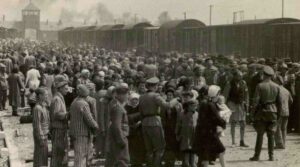When Netflix’s “Bridgerton” Season 2 aired earlier this year, it swept the internet into the kind of frenzy that only a juicy love story can.
The show takes place in an alternate past — an imagined history in which people of color occupy positions of power within English nobility. “Bridgerton” garnered praise for its inclusive casting and depiction of interracial romance. But in reality, the show’s source material features exclusively white main characters, as do the majority of historical romance novels.
WBUR is a nonprofit news organization. Our coverage relies on your financial support. If you value articles like the one you’re reading right now, give today.
And new fans hoping to pick up a juicy romance novel may find themselves disappointed by the lack of representation within the plotlines. However, some authors of color write historical romance about people of color, centering them and their experiences within the historical context of the story.
One of those authors is Beverly Jenkins. Known for her multicultural romance novels, Jenkins has been writing love stories about 19th-century Black Americans since the 1990s.
Jenkins’ first novel, “Night Song” was published in 1994 and features a romance between an Oberlin-educated school teacher with no family and cavalry officer in a Black town in Kansas.
But it wasn’t easy for Jenkins to convince publishers that there was an audience for her book: Publishers didn’t know what to do with a story about Black characters that wasn’t also about slavery.
“[Publishers] loved the writing but there was always ‘But, but, but’ and the but was ‘we don’t know anything about Black love. We don’t know anything about Black history,” Jenkins says. “That was my biggest challenge,” she added.
And Jenkins says focusing solely on the struggles of Black people erases the joy that their history also holds.
“They think that we get up every morning and we bemoan the fact that we are Black and struggling,” she says. “And they leave out the parts about birthday parties and that old couple at church who’ve been married for 50 years and are still holding hands walking to the parking lot. All of the things that bring joy to the rest of the world is a joy that we as people of color also celebrate.”
Many historical romance novels take place in Regency-era England and authors like Jenkins face criticism that including people of color in that setting is inaccurate to the time period.
New York bestselling author Courtney Milan says that argument doesn’t make much sense.
“I want to point out that the idea that historical romances have to be set in England is kind of weird to start off with because I believe there was history in other countries as well,” Milan says.
“When you’re talking about fiction, I’m not sure what the word inaccuracy means except something along the lines of, ‘I don’t want to believe in this particular fiction that you have come up with.’ It’s because they don’t want to recognize what has been in the past.”
And despite the absence of people of color in historical romance, the products of their labor are everywhere. And Jenkins says that including that history makes readers and publishers uncomfortable.
“I think every historical romance contains the products of people of color. Tea? Yeah. They all drink tea. Where did that come from? Cotton? Some of that cotton was produced in England, but a lot of it came from the slaveholding South,” Milan says. “Rum, sugar, china, silk: Most of the things that we see in historical romances that they use as markers of people’s wealth are actually trade goods that were produced by people of color.”
Milan says it also took her a long time to realize she could write historical romance that featured characters that share her heritage.
“I started writing books about white characters because that’s what I was reading. And I sort of innately felt like that’s what historical romance was. But as time went on … I started thinking to myself, I’m writing this book that’s set in 1870. That is when my great great grandparents first left China,” she says. “Why am I writing about white people when I feel that my heritage contains things that I’ve learned personally through my family history that no one’s writing about and that I think are important and interesting and would make a good story?”
But even while authors of color work to write more diverse historical romance, publishing has been slow to change.
Milan, who was temporarily expelled from the Romance Writers Association in 2019 for calling out racism within the genre on social media, says the romance canon is “radically stacked against representation.”
“I have never read a romance novel from Korea. The translation goes one way from English into other languages and it almost never comes back,” Milan says. “And I just wish we had more publishers thinking about publishing as a truly global endeavor.”
And as Jenkins notes, the tremendous success of “Bridgerton” on Netflix hasn’t led to any deals for authors of color writing historical romance.
“You have authors of color writing fabulous books, fabulous series, and ‘Bridgerton’ is the only one that’s been … picked so far,” Jenkins says. “You just got the one as the token. So you would hope that it would open the doors. But so far it has not.”
Historical romance recommendations:
- Beverly Jenkins recommends anything by Vanessa Riley
- Courtney Milan recommends Alyssa Cole’s “The Loyal League,” a trilogy set during the Civil War.
- Producer and resident romance bookworm Kalyani Saxena Jeannie Lin’s “The Jade Temptress“Kalyani Saxena produced and edited this interview for broadcast with Gabe Bullard. Saxena adapted it for the web.
WBUR participates in the Amazon Associates Program. When you purchase products through the Amazon.com link on this page, WBUR may earn a small commission which helps support our journalism and independent news.
This segment aired on August 8, 2022.Here & Now: Editors’ Picks




